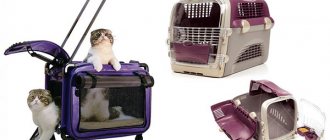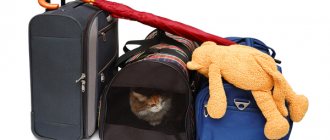Cats are homebodies and do not like to travel. But almost every owner sometimes has to transport their pets. Traveling to the vet, visiting friends on vacation, or moving to a new home can all be stressful for an animal. Even a small kitten quickly gets used to the house. Any new environment seems unusual and dangerous to him. He suddenly finds himself among many new smells, sounds, unfamiliar people and animals. Being calm while traveling doesn't mean everything is fine. The pet cannot run away or defend itself, as instinct dictates. Most likely, your pet is frozen in fear.
Even on short trips, it is advisable to ensure that the cat feels confident. This is necessary during a long journey. Otherwise, prolonged stress will lead to exhaustion of the cat’s body, the development of neuroses and serious diseases.
Proper preparation for travel will make life easier for the pet and its owners.
Where it all started
The most common question I hear is: why did I even decide to go somewhere with a cat?
I'll start from afar. Six years ago in November, I picked up a freezing gray kitten on a country plot, which soon turned into a huge gray cat, Dusya. She is very affectionate and loves to sit in my arms.
I have been traveling frequently for 10 years. Previously, I left Dusya and my second cat with my mother during trips. I constantly received alarming reports: either Dusya stopped eating, then she lay down on my clothes and slept all day, then she screamed all night and looked for me around the apartment. The second cat acted as if I had never been in her life. When I was about to leave again, my mother jokingly said: “Take your howling beast with you!” I thought and took it.
When I was first preparing to travel with a cat, I read many stories about difficulties with documents, cats’ inability to travel, injuries and deaths of animals during trips, and how cats damage property in hotels. There were reviews of escaped animals. Many people said: “If you go with a cat, you’ll go crazy!”
It turned out that everything is not so difficult, the main thing is to prepare correctly. But in the evenings, after all the adventures, you can relax and scratch your dear cat.
What vaccinations may be needed
Mandatory vaccination against rabies. It protects your pet from a deadly disease. In addition, without it it is impossible to enter the plane with the animal or cross the border of any country. It is mandatory to get vaccinated no later than 30 days before departure. During this period, antibodies are formed. In some countries, an antibody test result will be additionally required.
Viral rhinotracheitis, panleukopenia and calcivirus are fatal to cats. Sometimes the infection even gets into the apartment - on the owners’ shoes. When traveling, the risk of infection increases. It is advisable to protect your pet by getting vaccinated. In some countries, these vaccinations are required for entry.
After vaccination you will have to undergo quarantine: from 15 to 31 days. According to the requirements of the European Union - 21 days.
For the list of vaccinations required for entry, check the rules of the country you are going to. This will help avoid unpleasant surprises at the border.
I need to take my cat to the veterinary clinic, but I don’t have a carrier...
I'm afraid to carry it in my arms, because I'm already big and will break out. Tell me what to do?
I carried it in a travel bag with a zipper. She left a small gap, such that the cat could breathe, but could not jump out.
Yes, in the bosom - if the cat is smart, it will snuggle up to you and will not try to escape.
you can find a bag with a zipper anyway
Once upon a time I was bringing a cat from Hungary, a long time ago, in a box that he tore, I had to throw it away and put it in a suitcase, and even with things, the cat behaved quite well there, oddly enough. The moral is: anything that can be closed and opened will do. And then, by the way, I took him on the train on vacation and kept him on my shelf on a leash so that he wouldn’t jump around everywhere. Also very good.
Wrap your paws with tape and carry them
I traveled with a cat across the whole country by train, in Moscow we walked along Red Square, took the subway. We only had a harness (leash) in case the cat decided to flog in the capital). in general, you can put it in any bag, as long as the cat fits
I have a gorgeous carrier, but I carry it to the vet in my gym bag. It’s more convenient and there’s less staring.
I urgently need to buy a carrier! If there is no money for this, then the cat can be carried in a zippered bag. True, my cat almost tore this bag (when we didn’t have a carrier), but nevertheless, they brought it! But anything can happen! Better buy a carrier!
Source
What to take with you
- When traveling, you can't do without a carrier. It provides safety and ease of transportation. Choose a quality product: strong, spacious enough, with a secure door. Put the usual bedding and a favorite toy inside: with them the pet will feel calmer. For warm weather, it is better to choose a well-ventilated carrier. When it’s cold, insulate it.
- Lay out an absorbent diaper
and take spare ones: the cat may wet itself or knock over a bowl of water. - Collar with contact information
. In nature, a small LED flashlight will not hurt: with it you will not lose sight of the kitten. Attach an address tag to the carrier as well. Take a photo of your pet: this will make it easier to find if it gets lost. - A harness and leash
will come in handy if you need to remove the animal from its carrier. - Be sure to bring food and water bowls
and cleaning product. - water
with you: you won’t have to search for it, and your pet won’t get an upset stomach from unusual water. - On a long trip you will need a tray and the usual filler
, bags for waste. - blanket
is useful to protect against drafts . If the kitten is nervous, cover the carrier. Make sure that the blanket does not interfere with air access and does not cause overheating. - Pack a first aid kit
. If you are going to nature, be sure to bring antiseptic and dressing material. Do not use sedatives without consulting your veterinarian. It is advisable for a doctor to select medications for poisoning and allergies. - Documents
: it is necessary to obtain a veterinary passport and get vaccinations. To travel by public transport, the kitten will need a special ticket. - Wet wipes and clothes roller
. They will help you avoid trouble if your pet gets something dirty.
How to travel with a cat without going crazy
My cat visited six countries and more than ten regions of Russia in 2021. We managed to go with her on a big European tour of Austria, the Czech Republic, Germany, Poland and Switzerland.
During the pandemic, we flew to Turkey, visited Karelia, the Leningrad region, Kaliningrad and all the regions close to Moscow. And they returned from Dagestan with another cat.
A cat always makes a trip more homely. Someone else's apartment or a faceless hotel room becomes very cozy with it. The difficulties of the road no longer make you angry, because there is a fluffy antidepressant nearby. The world becomes like home when you have a cat on the road with you.
I’ll tell you how to understand whether your cat is ready to travel or is it better to leave him at home, how to prepare for the trip, what vaccinations and documents are needed and what difficulties you may encounter.
Spending on a cat on a trip - from 9580 RUR
| Passport, chipping, veterinary certificate (form 1) | 3000 R |
| Shipping | 2280 RUR for several trips |
| Flight | from 2000 R |
| Vaccinations | 1200 R annually |
| Soothing spray | 600 R |
| Supplement for housing | from 500 R per day |
Possible problems during the trip
Cats, like many other mammals, are prone to motion sickness in cars. There is no need to feed your pet right before the trip, otherwise the entire contents of its stomach may end up on the upholstery. At the first vomiting in the animal, you should stop the car.
If the cat has never been transported by car and its reaction to the trip is unclear, you need to get special tablets in advance. Veterinary pharmacies sell medications for motion sickness and vomiting.
Another serious danger for cats on the road (especially long-haired breeds) is overheating. In hot summers, the temperature inside a car can rise to critical levels, which often causes heat stroke.
Pay attention to the main signs of overheating in cats:
- frequent and heavy breathing with an open mouth;
- significant increase in body temperature;
- apathy;
- vomit.
If the air conditioner can't cope with the stuffiness, the cat needs help: drink water often to prevent dehydration, wet your hands with water and run them through the cat's fur. The interior of the car must be ventilated, but at the same time you need to be wary of drafts, because the animal may catch a cold.
You should not leave your cat in a parked car for too long, because your pet can overheat not only in the summer under the scorching sun, but also in winter by leaving the carrier near a hot stove.
There are cats that react excessively emotionally to trips. They can behave inappropriately, try to get out at any cost, hurting themselves and their owner. This kind of extreme stress can cause injury and serious illness. Therefore, some animals are given anesthesia or sleeping pills before the trip.
Remember that any sleeping drugs carry a serious burden on the body. Anesthesia can even be fatal for some cats. That is why it should not be abused and can only be used in the most extreme cases. You can administer anesthesia or give sleeping pills to your pet only under the supervision of a veterinarian.
How to train your pet to travel in a car
Many people get cats as companions who will always be close to the owner. But do not forget that cats are territorial animals that become strongly attached to their home. That is why they are not particularly inclined to travel frequently and for long periods of time. Let's look at how to transport a cat in a car without stress and accustom him to frequent trips.
First, you need to train him to carry him. You can lay animal bedding in it, put your favorite toy or put a feeder. The cat must learn to enter the carrier without fear and feel relaxed in it.
You need to gradually accustom your cat to a harness. First, put it on your pet without walking it for 10 minutes every day. Afterwards, attach a leash to the harness and walk around the apartment with the cat. When your pet gets comfortable, you can start walking outside.
It is advisable to accustom a kitten to a car from childhood. Just don’t forget that by this time your pet must have all the required vaccinations. First, the cat can be placed in the car. Let the animal examine and sniff everything.
When the cat gets used to it a little, you can start the engine. At first, the animal may be frightened by the loud sound and vibration, but over time it will get used to it. Afterwards, you can go with your cat to the park or nature. In this case, the pet must be treated for fleas and ticks.
How to check if your cat is ready to travel
The success of the trip depends primarily on the character of the pet and its upbringing. I recommend trying small moves first. The main thing is to be sure that he will be better off while traveling than at home without you.
Before the trip, you should make sure that the animal tolerates the road calmly and has a good or at least neutral attitude towards unfamiliar houses. First, put the cat in a carrier and walk with him in the yard. Perhaps already at this stage he will express a clear protest. If the experiment was a success, take the animal for a ride in the car. Observe how he feels, whether it is stressful for him or not. Then take your cat for a ride on public transport. If after this both the cat and you maintain the initial positive attitude, then read on.
Dusya regularly went to her parents' dacha by car and always behaved quite worthy of a traveler, so she automatically passed these tests.
How to beat burnout
Transportation rules
Transportation of pets
Long distance trains
Transportation of small domestic (pet) animals, dogs and birds on long-distance trains (no more than one seat per ticket and no more than two animals per seat are allowed in excess of the established carry-on baggage allowance). For the transportation of small domestic (pet) animals, dogs and birds on long-distance trains, a separate fee or the purchase of the entire compartment (superior carriages) or general carriages with class of service “3O” in the retro train “Ruskeala Express” may be required.
You can issue transportation documents on our website (more details). For the convenience of users, icons are placed in the buy ticket section depending on the class of service: pets are allowed. If there is no icon, then the transportation of animals is prohibited.
Please read the conditions for transporting pets depending on the class of service.
When transporting small domestic animals, dogs and birds, their owners or accompanying persons must ensure compliance with the sanitary and hygienic regime in the carriage.
On trains, large dogs are transported with muzzles and a leash: in a separate compartment of a compartment car, except for luxury cars, under the supervision of their owners or accompanying persons with payment of the full cost of all seats in the compartment without additional payment for their transportation, while the number of passengers traveling in The compartment for dogs and their owners or accompanying persons should not exceed the number of seats in the compartment.
The criterion for categorizing a dog as “large” or “small” is the ability to transport the animal in a carrier whose dimensions in the sum of three dimensions do not exceed 180 cm.
Animals and birds, the transportation of which may threaten the life and health of passengers and carrier employees, are not allowed for transportation.
Transportation across the territory of the Russian Federation of small domestic animals, dogs and birds on long-distance trains of Russian carriers is carried out without presentation of veterinary documents.
On commuter trains, it is permitted to transport small dogs without containers, muzzled, on a leash, and cats under the supervision of their owners or accompanying persons.











